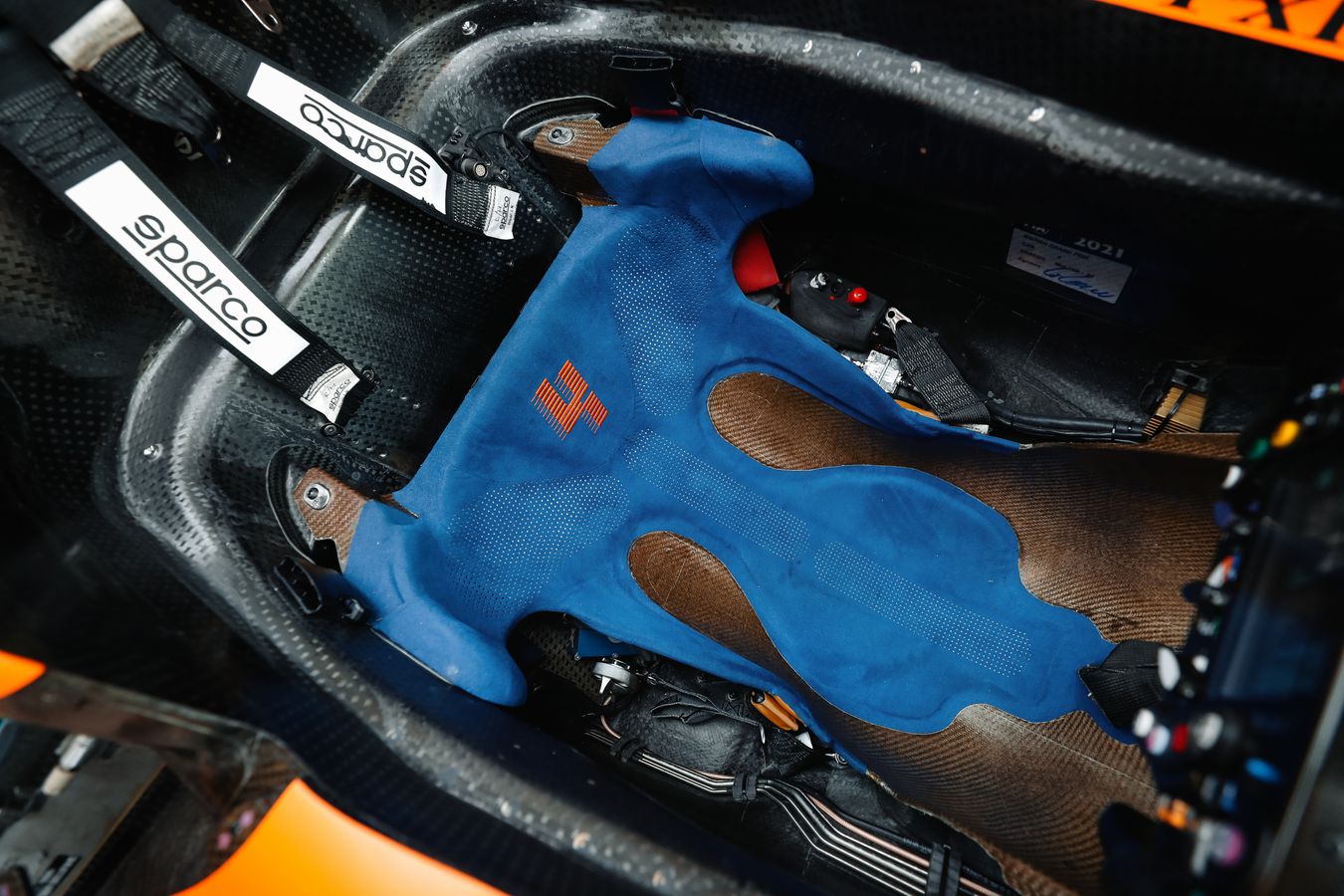McLaren has raced a seat design produced from natural fiber composites for the first time at the British GP. According to a lifecycle analysis (LFA) conducted by the team, the manufacture of the seat and production of flax-based materials netted a reduction in CO2 emissions of 85% compared with traditional composite construction.
McLaren started working with Swiss natural composite supplier Bcomp in 2020, when it released a concept design for the seat raced at Silverstone. “Together with McLaren, we analyzed the sustainability of the seat,” said Bcomp CEO and co-founder Christian Fischer. “In [McLaren driver] Lando Norris’s seat we can make use of all the sustainability and performance benefits of our AmpliTex and PowerRibs, resulting in 85% lower CO2 emissions.
“That means, even when taking into account the emissions in raw material production and manufacturing processes of the part, we can reduce the vast majority of the seat’s footprint by replacing all carbon fiber plies with an optimized flax natural fiber layup. If Lando’s seat needs to be replaced, since it is all natural fiber, it can be used for thermal energy recovery, turning approximately 80% of the energy stored in the seat into renewable energy.”
There were further sustainability benefits to be had in the manufacturing process, not least in reducing the consumption of single-use plastics. “By putting the PowerRib over the surface of the underlying structure that has resin in it, you get an even distribution of the vacuum within the bag during the autoclave process without the need for a plastic breather,” explained McLaren F1 composite design and technology engineer Steve Foster.
“Approximately 340g of single-use plastic per square meter is used as a breather in the production of a carbon-fiber part, but the PowerRibs eliminate the need for this.” An added benefit is that the removal of the breather allowed for tighter radii on the final autoclaved parts.
Notably, the seats constructed for drivers Norris and Daniel Ricciardo differ in construction. Norris’s seat was taken from a mold produced in 2020, but Ricciardo only joined the team this season. Design engineer Scott Bain explained, “Because Daniel was new to the team, he was an unknown quantity, we didn’t know exactly what he wanted from his seat, so we felt the safest bet was to stick with carbon fiber to reduce the chance of any problems.”
 Ricciardo is also slightly heavier than Norris, which meant he required a lighter seat. This limited the amount of additional bio-composite material the team could use to ensure his seat had the required levels of strength and stiffness, and as a result, a hybrid sandwich construction of flax and carbon fiber was chosen.
Ricciardo is also slightly heavier than Norris, which meant he required a lighter seat. This limited the amount of additional bio-composite material the team could use to ensure his seat had the required levels of strength and stiffness, and as a result, a hybrid sandwich construction of flax and carbon fiber was chosen.
Whereas Norris’s seat relies on Bcomp’s PowerRibs – thick yarns formed from twisted flax fibers – to provide a three-dimensional grid structure that reinforces the woven flax fiber reinforcement fabric, Ricciardo’s features a layer of AmpliTex sandwiched between two layers of carbon fiber. The net result is still a 25% reduction in CO2 emissions, with the added benefit of improved vibration damping from the natural fibers.
“By separating the carbon fiber skins in the seat, the AmpliTex is essentially enabling them to work much harder,” noted Foster. “The flax filling in this ‘sandwich’ construction plays an important role by transferring load between the inner and outer carbon skins and providing compressive strength through the thickness of the sandwich.
“It doesn’t need to be super strong and stiff itself to do this job, but by being much stronger than ‘normal’ core materials such as foams or honeycombs, it adds significant durability in ‘hardpoint’ areas – where the seat is supported in the cockpit and where it has to resist the highest stresses from cornering and grounding, for example.
“A solid carbon fiber construction would do the same job but would be unnecessarily expensive and take much longer to manufacture, aside from the additional environmental impact.”
McLaren has also looked to deploy the natural fiber composites in other areas of its operations, including the construction of its latest pitwall timing stand, which uses a similar hybrid carbon-flax sandwich layup. “The new timing stand and engineers’ island are two-thirds flax and one-third carbon fiber,” remarked Foster. “We could have made them entirely out of flax but, in our effort to minimize waste, we chose to use carbon fiber that was about to go out of date.”

Previously, the team had just one timing stand and engineers’ island made entirely of carbon fiber, which was transported around the world via air freight. However, by using such a high percentage of flax in the new design, it was cheaper to make five sets of the new timing stand and engineers’ island and transport them via sea freight, decreasing our amount of air freight and reducing the transport related emissions. In conjunction with the introduction of a new overhead lighting system for the garage, which also houses the power supply to the cars and equipment, the team has been able to reduce its traveling freight by 3,450kg.



